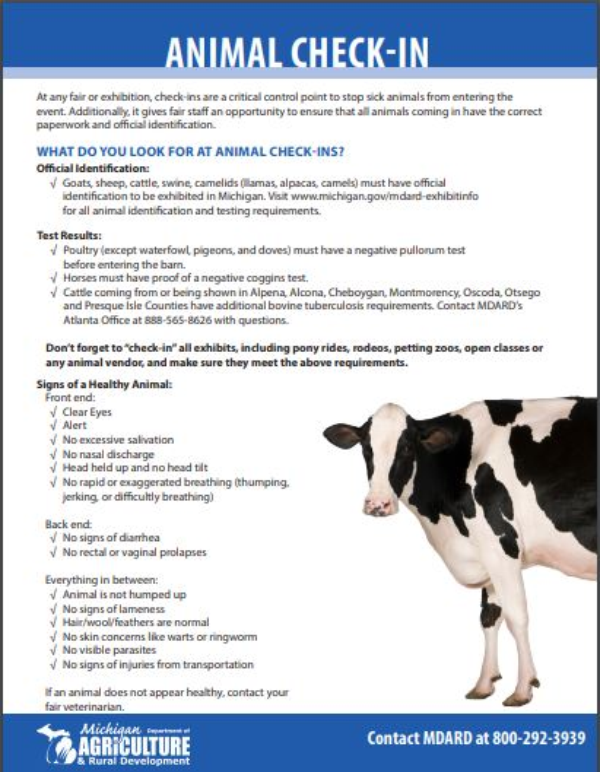
Animal Check-In
DOWNLOADJuly 30, 2019 - Michigan State University Extension
What do you look for at animal check-ins?
Official Identification:
Goats, sheep, cattle, swine, camelids (llamas, alpacas, camels) must have official identification to be exhibited in Michigan. Visit www.michigan.gov/mdard-exhibitinfo for all animal identification and testing requirements.
Test Results:
- Poultry (except waterfowl, pigeons, and doves) must have a negative pullorum test before entering the barn.
- Horses must have proof of a negative coggins test.
- Cattle coming from or being shown in Alpena, Alcona, Cheboygan, Montmorency, Oscoda, Otsego and Presque Isle Counties have additional bovine tuberculosis requirements. Contact MDARD's Atlanta Office at 888-565-8626 with questions.
Don't forget to "check-in" all exhibits, including pony rides, rodeos, petting zoos, open classes or any animal vendor, and make sure they meet the above requirements.
Signs of a healthy animal:
Front end:
- Clear eyes
- Alert
- No excessive salivation
- No nasal discharge
- Head held up and no head tilt
- No rapid or exaggerated breathing (thumping, jerking, or difficulty breathing)
Back end:
- No signs of diarrhea
- No rectal or vaginal prolapses
Everything in-between:
- Animal is not humped up
- No signs of lameness
- Hair/wool/feathers are normal
- No skin concerns like warts or ringworm
- No visible parasites
- No signs of injuries from transportation
If an animal does not appear healthy, contact your fair veterinarian.
How do you set up a check in?
- Be mindful of human safety and minimize animal stress.
- Have a single point of entry to your designated check-in outside of the barn.
- For large animals, have two people, so animals can be assessed before they are off-loaded and before they enter the barn.
- For small animals, assess the animals after they are removed from their transportation cage and before they enter the barn.
- Have a place to isolate ill animals. Animals may just be experiencing stress (especially on a hot day). Isolation allows the animal to relax, while ensuring that a sick animal is not being introduced to the other animals already in the barn.
- Don't offload animals that appear ill.
- If an animal appears ill, hold the animal to see if signs persist and contact the fair veterinarian.
- If one animal appears ill in a group, do not let any of the other animals in that group into the barn.
Who should perform the check-in?
Anyone with working knowledge of the species being inspected can perform the check-in. Some examples are 4-H leaders, barn superintendents, fair personnel, a veterinary technician or a veterinarian.
What are some good biosecurity practices?
- Removing animals from trailers and cages:
- Use disposable gloves or hand sanitizer between trailers or cages.
- Use disposable foot covers or sanitize your boots between trailers.
Animal handling areas:
Sanitize chutes, scales, tables and equipment (sorting boards, etc.) between groups of animals.
General area:
- Keep manure cleaned up in and around the check-in area.
- Limit the amount of people handling the animals.
- Minimize the sharing of equipment. When it is shared, disinfect between uses.



 Print
Print Email
Email



